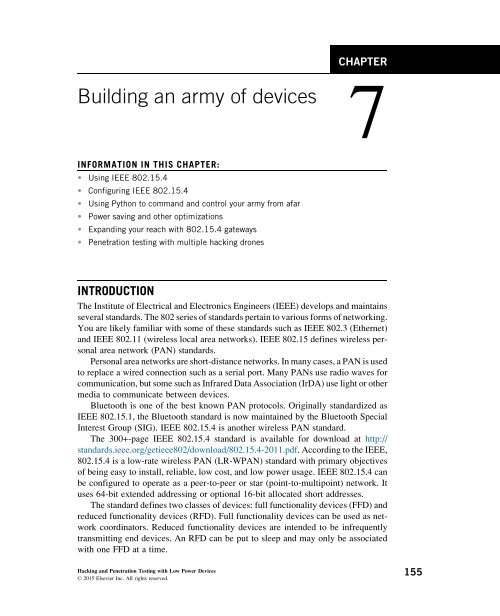Hacking_and_Penetration_Testing_with_Low_Power_Devices
You also want an ePaper? Increase the reach of your titles
YUMPU automatically turns print PDFs into web optimized ePapers that Google loves.
CHAPTER<br />
Building an army of devices<br />
7<br />
INFORMATIONINTHISCHAPTER:<br />
• Using IEEE 802.15.4<br />
• Configuring IEEE 802.15.4<br />
• Using Python to comm<strong>and</strong> <strong>and</strong> control your army from afar<br />
• <strong>Power</strong> saving <strong>and</strong> other optimizations<br />
• Exp<strong>and</strong>ing your reach <strong>with</strong> 802.15.4 gateways<br />
• <strong>Penetration</strong> testing <strong>with</strong> multiple hacking drones<br />
INTRODUCTION<br />
The Institute of Electrical <strong>and</strong> Electronics Engineers (IEEE) develops <strong>and</strong> maintains<br />
several st<strong>and</strong>ards. The 802 series of st<strong>and</strong>ards pertain to various forms of networking.<br />
You are likely familiar <strong>with</strong> some of these st<strong>and</strong>ards such as IEEE 802.3 (Ethernet)<br />
<strong>and</strong> IEEE 802.11 (wireless local area networks). IEEE 802.15 defines wireless personal<br />
area network (PAN) st<strong>and</strong>ards.<br />
Personal area networks are short-distance networks. In many cases, a PAN is used<br />
to replace a wired connection such as a serial port. Many PANs use radio waves for<br />
communication, but some such as Infrared Data Association (IrDA) use light or other<br />
media to communicate between devices.<br />
Bluetooth is one of the best known PAN protocols. Originally st<strong>and</strong>ardized as<br />
IEEE 802.15.1, the Bluetooth st<strong>and</strong>ard is now maintained by the Bluetooth Special<br />
Interest Group (SIG). IEEE 802.15.4 is another wireless PAN st<strong>and</strong>ard.<br />
The 300+-page IEEE 802.15.4 st<strong>and</strong>ard is available for download at http://<br />
st<strong>and</strong>ards.ieee.org/getieee802/download/802.15.4-2011.pdf. According to the IEEE,<br />
802.15.4 is a low-rate wireless PAN (LR-WPAN) st<strong>and</strong>ard <strong>with</strong> primary objectives<br />
of being easy to install, reliable, low cost, <strong>and</strong> low power usage. IEEE 802.15.4 can<br />
be configured to operate as a peer-to-peer or star (point-to-multipoint) network. It<br />
uses 64-bit extended addressing or optional 16-bit allocated short addresses.<br />
The st<strong>and</strong>ard defines two classes of devices: full functionality devices (FFD) <strong>and</strong><br />
reduced functionality devices (RFD). Full functionality devices can be used as network<br />
coordinators. Reduced functionality devices are intended to be infrequently<br />
transmitting end devices. An RFD can be put to sleep <strong>and</strong> may only be associated<br />
<strong>with</strong> one FFD at a time.<br />
<strong>Hacking</strong> <strong>and</strong> <strong>Penetration</strong> <strong>Testing</strong> <strong>with</strong> <strong>Low</strong> <strong>Power</strong> <strong>Devices</strong><br />
© 2015 Elsevier Inc. All rights reserved.<br />
155


